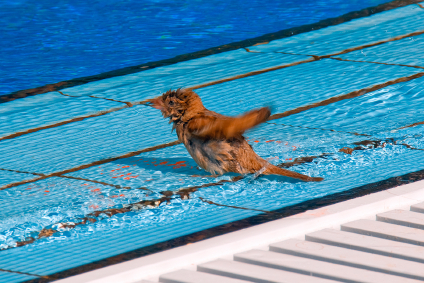
Birds are often attracted to swimming pools, spas and other water features in a backyard. The main concern with bird pests is the diseases they carry, especially those found in their droppings. Bird droppings are also very slippery when wet, which can create dangerous slip-and-fall hazards for children and even adults. While birds can be shooed away with the blast from a water hose or by banging pots and pans together, birds will invariably return when you leave.
If you have a bird problem around your pool, there are a number of things you can do to discourage pest birds from roosting and nesting near the immediate area. The first is to remove any plants that produce edible nuts, fruits and berries. You should also remove any bird feeders. And keep trees and large shrubs tightly trimmed, removing any branches that hang close to your pool. After you’ve taken these preliminary steps, you should invest in a professional bird deterrent. Here are some bird control devices the experts recommend:
Scarecrows Blast Bird Pests Away
Using a harmless blast of water to scare birds from your pool, Bird-B-Gone’s Scarecrow acts like a reliable 24/7 sentry. Any bird that enters this device’s area of protection will be showered with a “wake-up” water blast, alarming sprinkler sound, and Scarecrow’s realistic looking bird-like head. Easy to set up and use, Scarecrows connect directly to your garden hose. And each blast consumes just 2 to 3 cups of water. Scarecrows cover about 1,200 square feet with a spray that reaches out 35 feet and 45 feet wide (enough for most pools). Scarecrows are powered by a single 9-volt battery for up to 6 months, delivering over 1,000 "firings." The device’s sensitivity and coverage distance are easily fine-tuned to fit your pool’s shape and surroundings. Incidentally, kids and dogs love to play with these devices.
Sonic Bird Deterrents Scare Birds from Pools
While firecrackers and noisemakers may temporarily scare birds away, the more scientific (and long-term effective) approach is to intimidate birds with the sounds they dread to hear—their natural predators (like hawks and falcons). That’s where Bird-B-Gone’s Solar Bird Chase Super Sonic comes in. It broadcasts distress and predator calls birds know all too well. And they will seek the safety of someone else’s yard rather than stick around yours. The threatening birdcalls are repeated every ten minutes. The sounds emitted by Bird Chase device resemble natural birdcalls so they won’t bother your pets or neighbors. And unlike ultrasonic devices that emit high-frequency sounds birds can’t hear, the Bird Chase system creates sounds well within the hearing range of birds. Each Bird Chase device comes with a built-in speaker that will cover up to an acre.